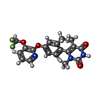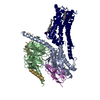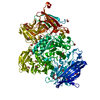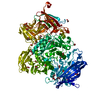[English] 日本語
 Yorodumi
Yorodumi- PDB-7cky: Cryo-EM structure of PW0464 bound dopamine receptor DRD1-Gs signa... -
+ Open data
Open data
- Basic information
Basic information
| Entry | Database: PDB / ID: 7cky | |||||||||||||||||||||
|---|---|---|---|---|---|---|---|---|---|---|---|---|---|---|---|---|---|---|---|---|---|---|
| Title | Cryo-EM structure of PW0464 bound dopamine receptor DRD1-Gs signaling complex | |||||||||||||||||||||
 Components Components |
| |||||||||||||||||||||
 Keywords Keywords | CELL CYCLE / signaling complex | |||||||||||||||||||||
| Function / homology |  Function and homology information Function and homology informationdopamine neurotransmitter receptor activity, coupled via Gs / dopamine neurotransmitter receptor activity / operant conditioning / cerebral cortex GABAergic interneuron migration / Dopamine receptors / dopamine binding / regulation of dopamine uptake involved in synaptic transmission / phospholipase C-activating dopamine receptor signaling pathway / peristalsis / heterotrimeric G-protein binding ...dopamine neurotransmitter receptor activity, coupled via Gs / dopamine neurotransmitter receptor activity / operant conditioning / cerebral cortex GABAergic interneuron migration / Dopamine receptors / dopamine binding / regulation of dopamine uptake involved in synaptic transmission / phospholipase C-activating dopamine receptor signaling pathway / peristalsis / heterotrimeric G-protein binding / modification of postsynaptic structure / G protein-coupled receptor complex / regulation of dopamine metabolic process / positive regulation of neuron migration / grooming behavior / habituation / sensitization / dopamine transport / astrocyte development / dentate gyrus development / striatum development / conditioned taste aversion / positive regulation of potassium ion transport / maternal behavior / arrestin family protein binding / non-motile cilium / long-term synaptic depression / mating behavior / adult walking behavior / G protein-coupled dopamine receptor signaling pathway / ciliary membrane / temperature homeostasis / D-glucose import / dopamine metabolic process / transmission of nerve impulse / PKA activation in glucagon signalling / G-protein alpha-subunit binding / G protein-coupled receptor signaling pathway, coupled to cyclic nucleotide second messenger / developmental growth / hair follicle placode formation / D1 dopamine receptor binding / behavioral fear response / prepulse inhibition / intracellular transport / positive regulation of synaptic transmission, glutamatergic / vascular endothelial cell response to laminar fluid shear stress / renal water homeostasis / activation of adenylate cyclase activity / neuronal action potential / Hedgehog 'off' state / behavioral response to cocaine / synapse assembly / adenylate cyclase-activating adrenergic receptor signaling pathway / cellular response to glucagon stimulus / presynaptic modulation of chemical synaptic transmission / regulation of insulin secretion / positive regulation of release of sequestered calcium ion into cytosol / response to amphetamine / adenylate cyclase activator activity / trans-Golgi network membrane / synaptic transmission, glutamatergic / negative regulation of inflammatory response to antigenic stimulus / G protein-coupled receptor activity / bone development / GABA-ergic synapse / visual learning / G-protein beta/gamma-subunit complex binding / platelet aggregation / vasodilation / cognition / memory / Olfactory Signaling Pathway / Activation of the phototransduction cascade / long-term synaptic potentiation / G beta:gamma signalling through PLC beta / Presynaptic function of Kainate receptors / Thromboxane signalling through TP receptor / G protein-coupled acetylcholine receptor signaling pathway / adenylate cyclase-activating G protein-coupled receptor signaling pathway / Activation of G protein gated Potassium channels / Inhibition of voltage gated Ca2+ channels via Gbeta/gamma subunits / G-protein activation / Prostacyclin signalling through prostacyclin receptor / G beta:gamma signalling through CDC42 / Glucagon signaling in metabolic regulation / protein import into nucleus / G beta:gamma signalling through BTK / Synthesis, secretion, and inactivation of Glucagon-like Peptide-1 (GLP-1) / ADP signalling through P2Y purinoceptor 12 / photoreceptor disc membrane / Sensory perception of sweet, bitter, and umami (glutamate) taste / Glucagon-type ligand receptors / Adrenaline,noradrenaline inhibits insulin secretion / Vasopressin regulates renal water homeostasis via Aquaporins / Glucagon-like Peptide-1 (GLP1) regulates insulin secretion / G alpha (z) signalling events / cellular response to catecholamine stimulus / ADP signalling through P2Y purinoceptor 1 / ADORA2B mediated anti-inflammatory cytokines production / G beta:gamma signalling through PI3Kgamma Similarity search - Function | |||||||||||||||||||||
| Biological species |  Homo sapiens (human) Homo sapiens (human) | |||||||||||||||||||||
| Method | ELECTRON MICROSCOPY / single particle reconstruction / cryo EM / Resolution: 3.2 Å | |||||||||||||||||||||
 Authors Authors | Yan, W. / Shao, Z. | |||||||||||||||||||||
 Citation Citation |  Journal: Cell / Year: 2021 Journal: Cell / Year: 2021Title: Ligand recognition and allosteric regulation of DRD1-Gs signaling complexes. Authors: Peng Xiao / Wei Yan / Lu Gou / Ya-Ni Zhong / Liangliang Kong / Chao Wu / Xin Wen / Yuan Yuan / Sheng Cao / Changxiu Qu / Xin Yang / Chuan-Cheng Yang / Anjie Xia / Zhenquan Hu / Qianqian ...Authors: Peng Xiao / Wei Yan / Lu Gou / Ya-Ni Zhong / Liangliang Kong / Chao Wu / Xin Wen / Yuan Yuan / Sheng Cao / Changxiu Qu / Xin Yang / Chuan-Cheng Yang / Anjie Xia / Zhenquan Hu / Qianqian Zhang / Yong-Hao He / Dao-Lai Zhang / Chao Zhang / Gui-Hua Hou / Huanxiang Liu / Lizhe Zhu / Ping Fu / Shengyong Yang / Daniel M Rosenbaum / Jin-Peng Sun / Yang Du / Lei Zhang / Xiao Yu / Zhenhua Shao /   Abstract: Dopamine receptors, including D1- and D2-like receptors, are important therapeutic targets in a variety of neurological syndromes, as well as cardiovascular and kidney diseases. Here, we present five ...Dopamine receptors, including D1- and D2-like receptors, are important therapeutic targets in a variety of neurological syndromes, as well as cardiovascular and kidney diseases. Here, we present five cryoelectron microscopy (cryo-EM) structures of the dopamine D1 receptor (DRD1) coupled to Gs heterotrimer in complex with three catechol-based agonists, a non-catechol agonist, and a positive allosteric modulator for endogenous dopamine. These structures revealed that a polar interaction network is essential for catecholamine-like agonist recognition, whereas specific motifs in the extended binding pocket were responsible for discriminating D1- from D2-like receptors. Moreover, allosteric binding at a distinct inner surface pocket improved the activity of DRD1 by stabilizing endogenous dopamine interaction at the orthosteric site. DRD1-Gs interface revealed key features that serve as determinants for G protein coupling. Together, our study provides a structural understanding of the ligand recognition, allosteric regulation, and G protein coupling mechanisms of DRD1. | |||||||||||||||||||||
| History |
|
- Structure visualization
Structure visualization
| Movie |
 Movie viewer Movie viewer |
|---|---|
| Structure viewer | Molecule:  Molmil Molmil Jmol/JSmol Jmol/JSmol |
- Downloads & links
Downloads & links
- Download
Download
| PDBx/mmCIF format |  7cky.cif.gz 7cky.cif.gz | 263.8 KB | Display |  PDBx/mmCIF format PDBx/mmCIF format |
|---|---|---|---|---|
| PDB format |  pdb7cky.ent.gz pdb7cky.ent.gz | 194.5 KB | Display |  PDB format PDB format |
| PDBx/mmJSON format |  7cky.json.gz 7cky.json.gz | Tree view |  PDBx/mmJSON format PDBx/mmJSON format | |
| Others |  Other downloads Other downloads |
-Validation report
| Summary document |  7cky_validation.pdf.gz 7cky_validation.pdf.gz | 1 MB | Display |  wwPDB validaton report wwPDB validaton report |
|---|---|---|---|---|
| Full document |  7cky_full_validation.pdf.gz 7cky_full_validation.pdf.gz | 1.1 MB | Display | |
| Data in XML |  7cky_validation.xml.gz 7cky_validation.xml.gz | 34.9 KB | Display | |
| Data in CIF |  7cky_validation.cif.gz 7cky_validation.cif.gz | 52.9 KB | Display | |
| Arichive directory |  https://data.pdbj.org/pub/pdb/validation_reports/ck/7cky https://data.pdbj.org/pub/pdb/validation_reports/ck/7cky ftp://data.pdbj.org/pub/pdb/validation_reports/ck/7cky ftp://data.pdbj.org/pub/pdb/validation_reports/ck/7cky | HTTPS FTP |
-Related structure data
| Related structure data |  30394MC  7ckwC  7ckxC  7ckzC  7crhC M: map data used to model this data C: citing same article ( |
|---|---|
| Similar structure data |
- Links
Links
- Assembly
Assembly
| Deposited unit | 
|
|---|---|
| 1 |
|
- Components
Components
-Guanine nucleotide-binding protein ... , 3 types, 3 molecules ABG
| #1: Protein | Mass: 45769.570 Da / Num. of mol.: 1 / Mutation: S205T,G226A,A366S Source method: isolated from a genetically manipulated source Source: (gene. exp.)  Homo sapiens (human) / Gene: GNAS, GNAS1, GSP / Production host: Homo sapiens (human) / Gene: GNAS, GNAS1, GSP / Production host:  |
|---|---|
| #2: Protein | Mass: 38257.770 Da / Num. of mol.: 1 Source method: isolated from a genetically manipulated source Source: (gene. exp.)  Homo sapiens (human) / Gene: GNB1 / Production host: Homo sapiens (human) / Gene: GNB1 / Production host:  |
| #3: Protein | Mass: 7861.143 Da / Num. of mol.: 1 Source method: isolated from a genetically manipulated source Source: (gene. exp.)  Homo sapiens (human) / Gene: GNG2 / Production host: Homo sapiens (human) / Gene: GNG2 / Production host:  |
-Antibody / Protein , 2 types, 2 molecules NR
| #4: Antibody | Mass: 16926.076 Da / Num. of mol.: 1 Source method: isolated from a genetically manipulated source Source: (gene. exp.)   |
|---|---|
| #5: Protein | Mass: 49339.168 Da / Num. of mol.: 1 Source method: isolated from a genetically manipulated source Source: (gene. exp.)  Homo sapiens (human) / Gene: DRD1 / Production host: Homo sapiens (human) / Gene: DRD1 / Production host:  |
-Non-polymers , 2 types, 2 molecules 


| #6: Chemical | ChemComp-CLR / |
|---|---|
| #7: Chemical | ChemComp-G3U / |
-Details
| Has ligand of interest | Y |
|---|---|
| Has protein modification | Y |
-Experimental details
-Experiment
| Experiment | Method: ELECTRON MICROSCOPY |
|---|---|
| EM experiment | Aggregation state: PARTICLE / 3D reconstruction method: single particle reconstruction |
- Sample preparation
Sample preparation
| Component |
| ||||||||||||||||||||||||||||||
|---|---|---|---|---|---|---|---|---|---|---|---|---|---|---|---|---|---|---|---|---|---|---|---|---|---|---|---|---|---|---|---|
| Source (natural) |
| ||||||||||||||||||||||||||||||
| Source (recombinant) |
| ||||||||||||||||||||||||||||||
| Buffer solution | pH: 7.4 | ||||||||||||||||||||||||||||||
| Specimen | Embedding applied: NO / Shadowing applied: NO / Staining applied: NO / Vitrification applied: YES | ||||||||||||||||||||||||||||||
| Vitrification | Cryogen name: ETHANE / Humidity: 100 % / Chamber temperature: 277.15 K |
- Electron microscopy imaging
Electron microscopy imaging
| Experimental equipment |  Model: Titan Krios / Image courtesy: FEI Company |
|---|---|
| Microscopy | Model: FEI TITAN KRIOS |
| Electron gun | Electron source:  FIELD EMISSION GUN / Accelerating voltage: 300 kV / Illumination mode: OTHER FIELD EMISSION GUN / Accelerating voltage: 300 kV / Illumination mode: OTHER |
| Electron lens | Mode: BRIGHT FIELD |
| Image recording | Electron dose: 64 e/Å2 / Detector mode: SUPER-RESOLUTION / Film or detector model: GATAN K2 SUMMIT (4k x 4k) |
- Processing
Processing
| Software | Name: PHENIX / Version: 1.17.1_3660: / Classification: refinement | ||||||||||||||||||||||||
|---|---|---|---|---|---|---|---|---|---|---|---|---|---|---|---|---|---|---|---|---|---|---|---|---|---|
| EM software | Name: PHENIX / Category: model refinement | ||||||||||||||||||||||||
| CTF correction | Type: PHASE FLIPPING AND AMPLITUDE CORRECTION | ||||||||||||||||||||||||
| 3D reconstruction | Resolution: 3.2 Å / Resolution method: FSC 0.143 CUT-OFF / Num. of particles: 672934 / Symmetry type: POINT | ||||||||||||||||||||||||
| Refine LS restraints |
|
 Movie
Movie Controller
Controller
















 PDBj
PDBj




























